Chapter Twenty-four
[The first two-thirds of this chapter appears near the beginning of the English edition under the title “A Friendship.” The rest is omitted.]
That year, the BHD Company made a feature film entitled The Dance of the Cranes. This was perhaps the first indication that the BHD Company was going to invest in film production. The chiefs of this company were a young couple, Bình (or Bình Boong) and his wife. Bình’s mother’s name was Hảo, Phan Thanh Hảo. They had been my friends from my days of poverty and obscurity—the period of Hanoi in Whose Eyes, so full of uncertainty and rebuffs. Bình’s wife was Hạnh, Ngô Bích Hạnh. His father was Ngô Thảo, a person with whom I was also on friendly terms. I had known these young people from the time they were little, and I quietly admired them for their innate abilities and for the light and easy steps they took into adulthood. When The Dance of the Cranes was made, I knew nothing of the film. Suddenly one day, Bình came to my house to discuss ways of fixing it. He said that their film was finished, but had the drawback that the person in the role of the war correspondent who narrates the film was too young (this role was being played by Lưu Vinh, the younger brother of Lưu Hà, and the son of Lưu Xuân Thư). Bình said that his mother and his father Ngô Thảo had proposed te idea of putting “Uncle Thủy” (me) in this role—it would be more appropriate. “You are old enough,” Bình said, “and you were actually a war correspondent for many years.
I received the invitation of these young people in a noncommittal manner, never suspecting that, thanks to them, I would soon have a very straightforward and sincere American friend, Wayne Karlin.
I said to them, “I’ve always made documentary films; I’m not able to dream up stories the way narrative film-makers do. So in the part I contribute, please allow me to say only things that are true, to speak only of experiences that I actually had in wartime, and not follow a pre-written script at all. Also, if possible, the role of the former American GI who talks with me should be played by a former helicopter gunner. You should be aware that in the war zone back then, I was most afraid of helicopters. As for infantry soldiers, B52s, B57s, and gunships—I wasn’t afraid of them. I was afraid of helicopters because they could finish me off in an instant, anywhere. They chased me like a cat chasing a mouse, and death could catch me in the blink of an eye.
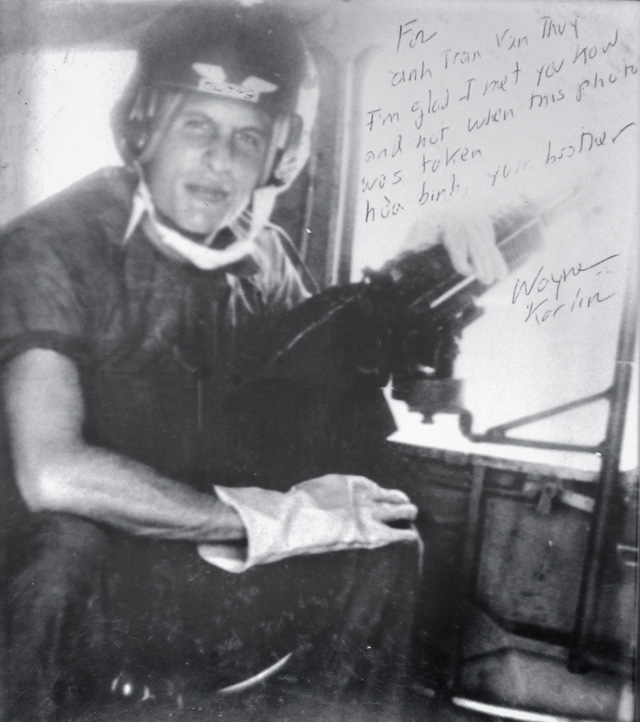
Wayne on the helicopter.
Bình and Hạnh agreed to all this! Only a few days later they invited me to their house at the head of Lê Ngọc Hân Street, so I could meet my “co-star.” When this happened, I was astounded—not just taken by surprise. Before my eyes stood a former American GI, towering and gentle. At first he seemed to suffer a bit from shame, for he had been a gunner on a helicopter in South Vietnam in just about the same time and location where I had been. His name was Wayne Karlin.
This was surely a wondrous thing! Here was a privately produced film—but in only a few days they had requisitioned an “actor” from the US (or to be more exact, Maryland in the eastern part of the US) having precisely this background, and had him come to Vietnam. Our government-run film studios would never have been able to do such a thing!
Wayne, Bình, Hạnh, Phan Thanh Hảo, and I chatted with each other for quite a while. In the days that followed, when we walked into the settings that were to be filmed, beneath a banyan tree, or on a village road, or a river dyke on a rainy day, or next to farmers harvesting or threshing rice, or spreading straw to dry, we ambled along amid these backdrops and spoke only of things we had actually experienced in our own parts of the war. I didn’t hesitate to observe that I feared and hated Wayne’s helicopters more than anything, and Wayne confessed that when sitting up high, he had shot at anything that moved on the ground.
Later, when I went to the US in 2002, I compiled a book with Wayne and my friends, in which Wayne wrote everything he had said in the film, and added a further passage:
“When I met him (Trẩn Văn Thủy) in Vietnam, and he confided to me how afraid he had been of helicopters back then, I was deeply shocked and saddened, because I knew that if I had seen him on the ground back then, I would have shot him dead without the slightest pity or regret; and if I had done this, humankind would have suffered an unimaginable loss. (If You Go To the End of All the Seas, Thời Văn, CA, 2004, p. 157).
During my subsequent visit to the US, Wayne and I shared many memorable moments. He invited me to talk with students at the school where he taught: St. Mary’s, near Washington DC. Wayne was a teacher of language and literature. He was also the author of four novels that had been given prestigious awards in the US. One thing I noticed was that in the US many people who, like Wayne, had returned from the war continued to study and conduct research, with the result that they attained success in such fields as science, literature, art, politics, sociology, and business. Many became outstanding statesmen, directors, congressmen, and presidential candidates.
And yet when they participated in the war and got captured, they were just common soldiers, or “half-breed bandits.”
Then when I turned my thoughts to Vietnam, I saw phenomena of the same nature. After serving in the war, former soldiers for the most part worked laboriously and energetically at earning a livelihood, but a few rose higher still, and grew successful in different areas of social activity.
Because he was a former military man who had taken part in fighting, and was an author as well, Wayne brought a great deal of experience and vision to his academic writing and teaching. Together with two other Americans, he joined with me in taking seventeen US, students of documentary filmmaking in the New York Cinema Institute to Vietnam for hands-on training. These youngsters were all American, but they came from different backgrounds: some were white, some black, and some yellow. Three were of Vietnamese background. Their point of entry to Vietnam was the Nội Bày Airport near Hanoi. On the first night they gathered at Sóc Sơn and built a campfire; then they came to Hanoi and visited the Temple of Literature and the various museums. After that they went on a tour through all the regions of Vietnam. Each student was outfitted with two cameras, so they could film scenes in a professional manner. The aim was to have them use these scenes to make four documentary films concerning Vietnam on their return to the US.
Wayne knew all the wartime sites and battles by heart. His memory was marvelous. He gave lectures to his students whenever we came to famous places in the Central Region, such as the river Bến Hải, Cồn Tiên, Dốc Miếu, Khê Sanh, Tà Cơn, Gio Linh, and Cửa Việt… Thus the students had many notable experiences that would leave lasting impressions on their young minds.
Wayne had a quasi-superstitious belief in the explanatory lectures I gave to the students, not exactly because I had experienced the war, or survived the war, and not exactly because I was a documentary film director who had won international prizes; perhaps Wayne needed me in this trip for the simple reason that he valued me, and because he had come close to killing me with the muzzle of the gun that he operated on the helicopter back then.
When we got to the ocean shore in northern Dằ Nẵng, the water was crystal clear and there were no waves surging against the shore. The surroundings were still, with rows of verdant willow trees. Wayne went to the edge of the water, and everyone gathered around him. Moved, he spoke slowly and with emphasis:
“Fellow students! The place where we are now standing is the place where, on March 8, 1965, a great historical tragedy began for the United States. That was the day that American troops for the first time poured onto Vietnamese soil. It was here!”
“Oh Wayne, you were a very tactful person! You just said “The place where we are now standing…” But I could have been more even-handed: “This is a place where a great tragedy for the Vietnamese people began.”
I suggested that we take the students to the site at Mỹ Lai after inviting them to see The Sound of a Violin at Mỹ Lai.
It was indeed a “prizewinning” film. The images and remains at Mỹ Lai shocked the students more than Wayne and I could imagine. Many students wept piteously.
I was sorry for them, and sorry as well for Mike Boehm, who was so cruelly haunted and tortured by the past.
We took them to many other places, and the students conscientiously recorded scenes and stories. I always said to them, “It is best if, when you start shooting a scene, you have in mind how you will use that scene in your film, and what the preceding and subsequent scenes will be.”
On the last night we had a banquet at the New World Hotel in Saigon. It was a truly affecting scene of parting.
At the end of the banquet, a person suggested that we should have the students roam freely around the streets of the city, but I made a counter suggestion: that we divide them into four groups, each with a camera. Each student expressed his feelings with regard to the Vietnamese journey he had just completed. The students were shot at close range, one after the other, as they spoke. I could never have imagined beforehand what happened or what the students would say. We all know that whenever Europeans or Americans get in front of a camera, they are self-confident, natural, and straightforward. These students were no exception. They all talked about their thoughts and feelings before and after they set foot in Vietnam, and their thoughts were extremely sincere and moving. Some wept as they spoke, and some people standing next to the speakers wept, and even the person pressing the buttons on the camera at times wept. Wayne said, close to my ear, “There is no author who can say such true, moving, and accurate things.”
I said to the students, “You have done a glorious and important thing this evening in speaking of your thoughts and feelings about war, and about the Vietnam war, before and after you came to Vietnam. As people studying to learn a profession, you must surely all understand that the hours of film you have just shot on these four cameras can serve to communicate the themes of your films. They can serve as the opening words, or concluding words, and can also occur as commentary in the course of your films. There is no author, not even Wayne, your teacher, who can do better than that.”
The students all loved and valued me, and some regarded me as a father. Before we parted many students embraced me and sobbed; and they left behind farewell notes full of feeling…
As for Wayne, before he took leave of me, he gave me a sweatshirt upon which were embroidered the words “College of Southern Maryland, CSM 1958”—a souvenir of St. Mary’s in Maryland. That was his school, the place where I had visited him. He also gave me a photograph.
I’ll say a few words about this souvenir. It was a black and white photograph in a wooden frame, 20 by 16 millimeters. In it is Wayne as a youth, sitting in a helicopter, wearing a uniform and a flight cap, with his arms cradling a fast machine gun. It is a wartime photograph dating from the time when he and I were in the war zone at the same place and the same time—so how could such a photo be a gift from one to the other? It shouldn’t be given—it would reawaken such painful memories. It couldn’t possibly be given! But Wayne gave me that picture. I held the picture in my hands and was very moved when I read the inscription:
For anh Trần Văn Thủy. I’m glad I met you now, and not when this photo was taken.
Hòa bình [“peace”], your brother, Wayne Karlin.
The word “anh” was written in Vietnamese and was used in conjunction with the word “brother” in the next line… so one can see that Wayne was very sensitive to the nuances of Vietnamese.
It was terrific, don’t you think?
As a documentary film director, I understand that there can be no image that is “forbidden to use”; the problem is one of placement, the words used to accompany it, and the meaning of the image in context.
An inscription as a fine and meaningful as this one could only have come from a true writer like Wayne.
[the rest of this chapter, dealing with the reactions of American students to TVT’s films, is omitted in the English edition]
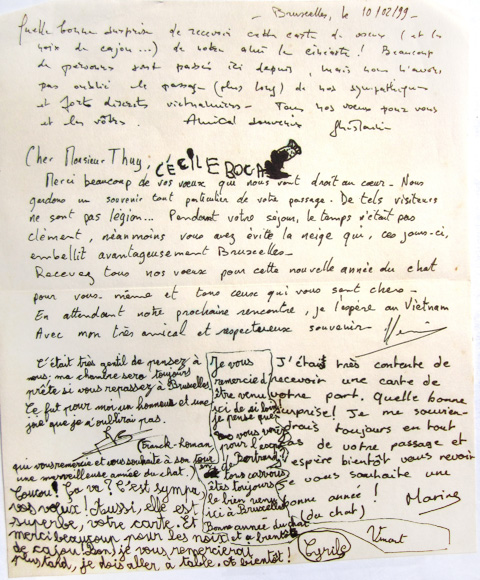
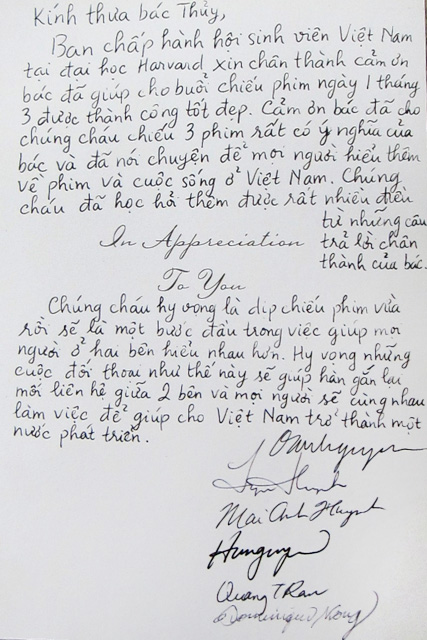
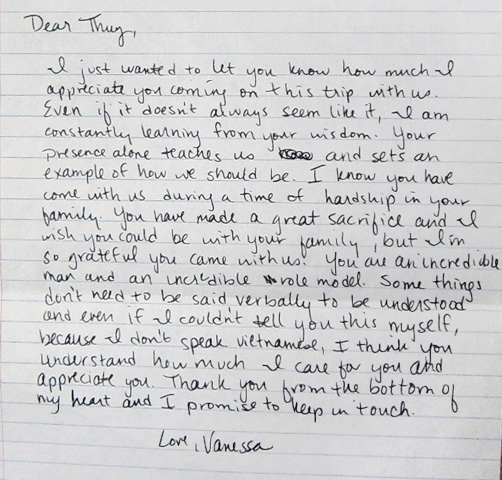
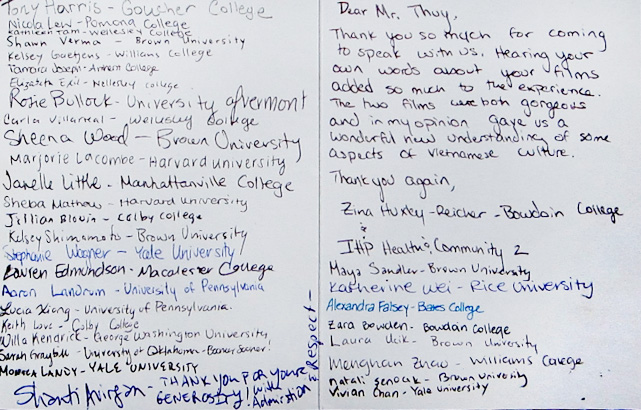
The farewell notes of the American and European film students.
I want to say a few words about American audiences and especially about the American students I have met. I have gone to the US many times. Aside from professional assignments, such as writing about the Vietnamese community in the US in response to the invitation of the WJC in Massachusetts, I have participated in film festivals held in New York, Florida, Madison (Wisconsin), and Brooklyn, and have participated in conferences organized by independent producers, such as the Robert Flaherty Film Seminar, a sociology conference at New York University, and a conference on agent orange in Riverside, California.
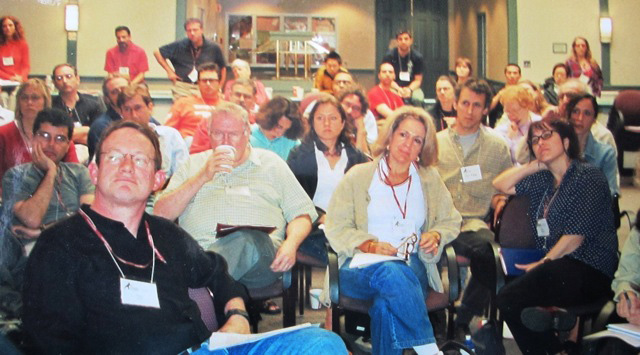
The conference of independent producers: the Robert Flaherty Film Seminar.
I have given or participated in a hundred talks and discussions at showings of my films in more than thirty colleges and universities on both the east and west coasts of the United States. These are what most occupied my time. Sometimes a place would have just two events, and sometimes I would remain a whole week. The crowds were great; sometimes there were more than four hundred people, in other places less, say around two hundred.
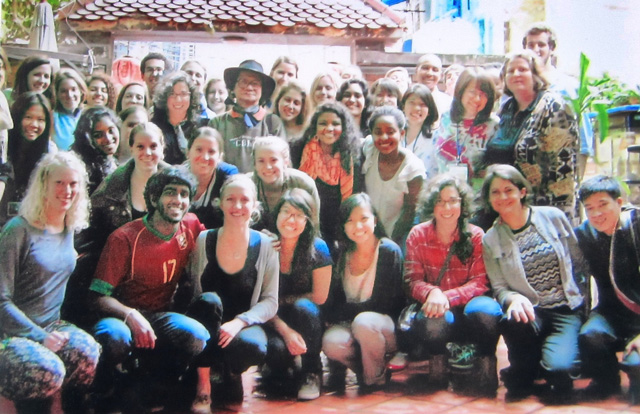
With students from American universities who had come to Vietnam for hands-on training.
In this way I’ve had the good fortune to make the acquaintance of tens of thousands of American students, and thousands of former American military men and intellectuals. One can say that in the US, the environment provided by colleges is a separate world. I have such distinct impressions of American education, and with many aspects of American universities, that by rights I should write something separate concerning this very useful topic.

Harvard—one of the universities that has trained the people who rule the world.
As I have observed above, I feel that American students, with their various innate abilities and characteristics, have come to be what they are over many generations, and that they are the essential core of American education.
In Vietnam, many people, on many occasions, have discussed “reforming education.” The proposals that people have advanced are all needful and reasonable, but the essential core of education is the human character, the innate skill, the ability, of the students. This means that the reform of education must encompass many aspects, but the most needful thing to consider is the “stuff” of each student. This is not something that can be produced in an instant.
The American youngsters I met were very enthusiastic, and questioned and conversed with me even on very distant and abstruse matters, such as “Is the Hồng Đức Legal Code in the fifteenth century during the reign of Lê Thánh Tông taken very seriously in Vietnam?” “Was land reform in Vietnam an example of kind behavior?” “In what respect are Bush and the Republican party right or wrong in attacking Iraq?” “Why was the massacre at Mỹ Lai made the subject of a film, while the 1968 Tết massacre wasn’t?” “Do Vietnamese people have long-lasting hatreds?” “Is Vietnamese society more democratic, or was the former Republic of Vietnam more democratic?”
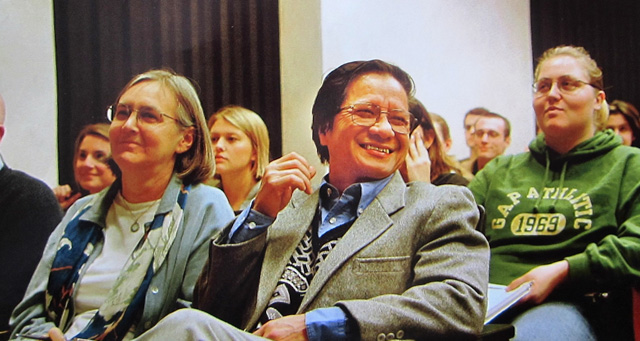
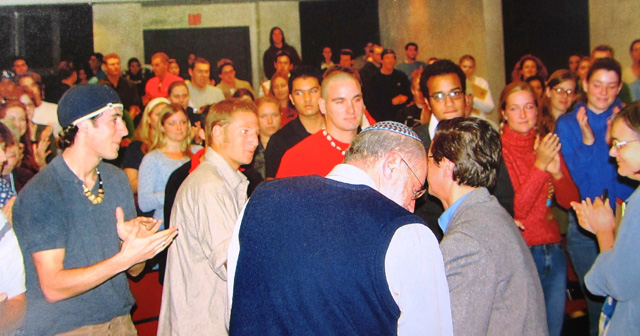
The warm atmosphere at the discussion meeting in the psychology department of the University of California at Santa Barbara.
Before people of such active intelligence and such a solid educational foundation, one’s answers must be strictly worded, incisive, direct, and must address with due weight the issues raised in the questions. Otherwise one’s answers will simply be a waste of time, and will fail to win the sympathy and respect of the audience.
The students of Vietnamese descent at Harvard treated me with great warmth. This made me very happy, and so I ask permission to express my gratitude for them here.
Sometimes I get a little dotty, and imagine that after twenty of thirty more years, in the middle of the 21st century, all these students have become scientists, statesmen, people of accomplishment in other fields, or ordinary citizens of the United States, and that among the tens of thousands of students that I have met, there will be a few who will think back to the old days when they met a person from Vietnam who delighted them. That alone is a great favor that life has conferred on me.
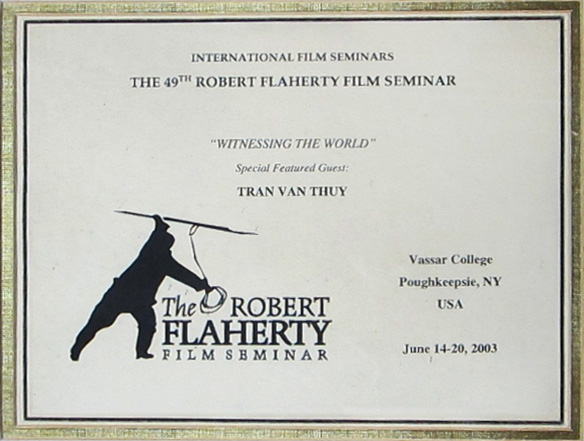
A souvenir of the 49th Robert Flaherty Film Seminar.
(LTD:) In Thủy’s living room, in an inconspicuous place on the wall where few people notice it, is a paper certificate elegantly encased in glass.
I read it over.
International Film Seminars. The 49th Robert Flaherty Film Seminar “Witnessing the World.” Specially featured guest Trần Văn Thủy. Vassar College, Poughkeepsie, NY, USA—June 14–20, 2003.
What does “Witnessing the World” signify in our language? I think that “witnessing” shouldn’t be understood as “chứng nhân” (“serving as a witness to something”) and that “world” refers to something huge and not too specific. So I beg permission to render the term for now as “Chứng kiên [“observing”] Thế Gian [the realm where people live”], which seems to me in some sense a little closer, and more reflective of the meaning. If it is wrong, I beg your pardon, and beg to be corrected.
Order In Whose Eyes from the University of Massachusetts Press, or from Amazon.
All text and images are © 2023, Trần Văn Thủy, all rights reserved. Written permission is required for any use.